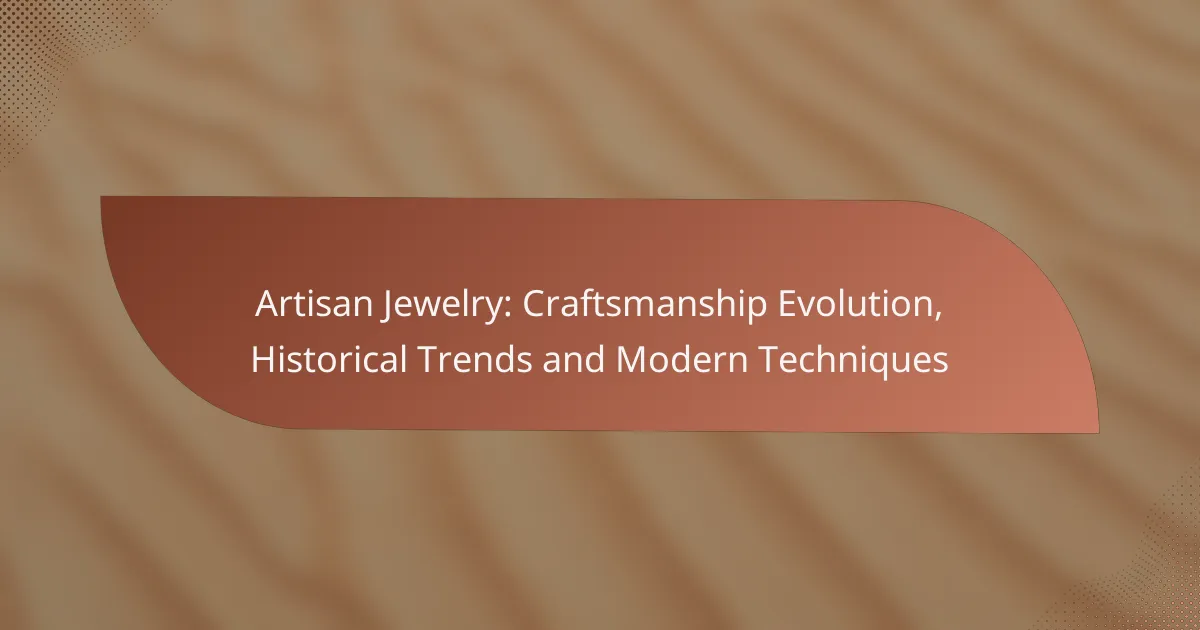Artisan jewelry has undergone a remarkable evolution, merging ancient craftsmanship with modern design techniques. This transformation highlights a rich tapestry of cultural influences and innovative practices, resulting in distinctive pieces that celebrate personal expression and individuality. As contemporary trends lean towards sustainability and uniqueness, consumers are increasingly drawn to jewelry that not only reflects their style but also aligns with their values.

How has artisan jewelry evolved over time?
Artisan jewelry has transformed significantly from ancient craftsmanship to contemporary design, reflecting changes in techniques, cultural influences, and technology. This evolution showcases a blend of traditional skills and modern innovations, resulting in unique pieces that resonate with personal expression.
Historical craftsmanship techniques
Historical craftsmanship techniques in artisan jewelry include methods such as lost-wax casting, granulation, and filigree. These techniques have been passed down through generations, often requiring extensive training and skill to master. For example, lost-wax casting allows for intricate designs that are difficult to achieve with other methods.
Many artisans still use these traditional techniques today, often combining them with modern tools to enhance precision and efficiency. The blend of old and new techniques creates a distinctive aesthetic that appeals to collectors and enthusiasts alike.
Influence of cultural movements
Cultural movements have played a significant role in shaping artisan jewelry styles and techniques. For instance, the Art Nouveau movement emphasized organic forms and intricate designs, while the Arts and Crafts movement focused on handmade quality and natural materials. Each movement brought forth unique aesthetics that influenced artisans’ approaches to jewelry making.
Today, global influences continue to inspire artisans, leading to diverse styles that reflect various cultural heritages. This cross-cultural exchange enriches the artisan jewelry landscape, allowing for innovative designs that celebrate both tradition and modernity.
Modern adaptations in design
Modern adaptations in artisan jewelry design often incorporate unconventional materials and innovative techniques. Artisans are experimenting with materials like resin, recycled metals, and ethically sourced gemstones, which appeal to environmentally conscious consumers. This shift not only enhances creativity but also aligns with contemporary values around sustainability.
Additionally, the use of digital tools, such as 3D printing, has revolutionized the design process, enabling artisans to create complex shapes and patterns that were previously unattainable. These adaptations allow for greater personalization and customization in jewelry pieces.
Key historical figures in artisan jewelry
Key historical figures in artisan jewelry include renowned artisans like Peter Carl Fabergé, known for his exquisite Fabergé eggs, and René Lalique, celebrated for his Art Nouveau jewelry. Their innovative techniques and artistic vision set high standards in the industry and continue to inspire modern artisans.
These figures not only advanced craftsmanship but also influenced the aesthetic direction of jewelry design, establishing a legacy that resonates in contemporary artisan practices.
Impact of technology on craftsmanship
The impact of technology on craftsmanship in artisan jewelry has been profound, enhancing both the creation process and the final product. Tools such as laser cutting and computer-aided design (CAD) have increased precision and efficiency, allowing artisans to produce intricate designs with greater accuracy.
However, while technology offers numerous advantages, it also presents challenges. Some artisans may struggle to maintain the traditional aspects of their craft in an increasingly digital landscape. Balancing technology with handcrafting techniques is essential for preserving the authenticity of artisan jewelry.

What are the current trends in artisan jewelry?
Current trends in artisan jewelry emphasize individuality, sustainability, and innovative techniques. Consumers are increasingly seeking unique pieces that reflect personal style while also considering the environmental impact of their purchases.
Popular materials used today
Artisan jewelers are utilizing a diverse range of materials, including recycled metals, ethically sourced gemstones, and alternative materials like wood and resin. These choices not only enhance the uniqueness of each piece but also align with eco-conscious consumer preferences.
Natural materials such as pearls, leather, and organic stones are also gaining popularity, appealing to those who appreciate a more rustic or organic aesthetic. The use of these materials often results in one-of-a-kind creations that tell a story.
Eco-friendly practices in production
Many artisans are adopting eco-friendly practices by minimizing waste and using sustainable sourcing methods. Techniques such as upcycling old jewelry or using lab-grown gemstones help reduce the environmental footprint of production.
Additionally, some jewelers are implementing energy-efficient processes and using non-toxic materials in their workspaces. This commitment to sustainability not only attracts environmentally conscious customers but also fosters a positive brand image.
Customization and personalization trends
Customization is a significant trend in artisan jewelry, with many consumers desiring pieces that reflect their personal stories or milestones. Jewelers often offer options for engraving, selecting specific stones, or designing entirely bespoke items.
This trend encourages a deeper connection between the buyer and the piece, as personalized jewelry often becomes a cherished keepsake. Artisans may also leverage technology, such as 3D printing, to create unique designs that cater to individual preferences efficiently.

How to choose artisan jewelry for personal style?
Choosing artisan jewelry that reflects your personal style involves understanding your preferences, matching pieces with your outfits, and considering the occasion. By focusing on these aspects, you can select unique pieces that enhance your individuality and complement your wardrobe.
Identifying personal style preferences
Begin by assessing your personal style preferences. Consider whether you lean towards classic, bohemian, modern, or eclectic looks. Take note of colors, materials, and designs that resonate with you, as these elements will guide your jewelry choices.
Creating a mood board or collecting images of jewelry that you admire can help clarify your style. Look for patterns in the pieces you are drawn to, such as specific gemstones, metals, or shapes, which can inform your selections.
Matching jewelry with outfits
When matching artisan jewelry with outfits, consider the overall aesthetic you want to achieve. For casual wear, opt for simpler, more understated pieces that add a touch of elegance without overwhelming your look. For formal occasions, choose statement jewelry that enhances your outfit and draws attention.
Keep in mind color coordination; jewelry should complement the colors in your clothing. For example, gold and warm-toned stones pair well with earthy colors, while silver and cool-toned stones suit cooler palettes. A quick tip is to match the metal of your jewelry with the tones in your outfit for a cohesive look.
Considering occasion and wearability
Consider the occasion when selecting artisan jewelry. For everyday wear, choose durable pieces that can withstand regular use, such as simple earrings or a classic pendant. For special events, you might opt for more intricate designs that showcase craftsmanship and artistry.
Wearability is also crucial; ensure that the jewelry is comfortable and suitable for the activities you’ll be engaging in. Avoid overly heavy pieces for long wear, and consider how the jewelry interacts with your clothing, such as snagging or clashing with fabric textures.

What are the best platforms for purchasing artisan jewelry?
The best platforms for purchasing artisan jewelry include a mix of online marketplaces, e-commerce sites, and local artisan markets. Each option offers unique benefits, from supporting local artisans to accessing a wider range of handmade pieces.
Top e-commerce sites for artisan pieces
Popular e-commerce sites like Etsy and Amazon Handmade are excellent for finding artisan jewelry. Etsy features a vast selection of unique, handcrafted items from independent creators, while Amazon Handmade offers a curated collection from artisans worldwide.
When shopping on these platforms, consider seller ratings and reviews to ensure quality. Look for items that provide detailed descriptions and clear images to assess craftsmanship accurately.
Local artisan markets in major cities
Local artisan markets are vibrant spaces where you can find unique jewelry directly from creators. Cities like New York, Los Angeles, and London host regular markets that showcase local talent and handmade goods.
Visiting these markets allows you to engage with artisans, learn about their techniques, and often negotiate prices. Check local event listings for upcoming markets and seasonal fairs to discover new artisans.
Online marketplaces for handmade jewelry
Online marketplaces such as ArtFire and Zibbet specialize in handmade jewelry, offering a platform for artisans to sell their creations. These sites often feature a variety of styles and price points, making it easier to find something that fits your taste and budget.
When using these marketplaces, pay attention to the return policies and shipping options. Many artisans provide custom orders, so don’t hesitate to reach out if you’re looking for something specific or personalized.

What are the pricing factors for artisan jewelry?
The pricing of artisan jewelry is influenced by several key factors including material costs, craftsmanship, and market demand. Understanding these elements can help both buyers and creators navigate the artisan jewelry landscape effectively.
Material costs and sourcing
Material costs are a significant factor in the pricing of artisan jewelry. The choice of metals, gemstones, and other materials directly impacts the overall cost. For instance, precious metals like gold and platinum are generally more expensive than silver or base metals.
Sourcing also plays a crucial role. Ethically sourced materials, such as conflict-free diamonds or recycled metals, may come at a premium but can enhance the jewelry’s value and appeal. Buyers should consider the origin of materials when assessing price.
Additionally, fluctuations in market prices for raw materials can affect pricing. For example, if gold prices rise, the cost of gold jewelry will likely increase as well. Keeping an eye on market trends can help both artisans and consumers make informed decisions.
